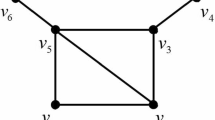Abstract
This paper presents an algorithm for constructing a cactus representation for all minimum cuts in an undirected network. Our algorithm runs in O(nm + n2 logn + γm logn) time, wheren andm are the number of vertices and edges respectively, and γ is the number of cycles in a cactus representation, which is the one of the best deterministic time complexities to compute a cactus representation.
Similar content being viewed by others
References
A.A. Benczúr, Augmenting undirected connectivity in RNC and in randomized Ō(n3) time. Proc. 26th ACM Symposium on Theory of Computing, 1994, 658–667.
E.A. Dinits, A.V. Karzanov and M.V. Lomonosov, On the structure of a family of minimal weighted cuts in a graph. Studies in Discrete Optimization (in Russian) (ed. A.A. Fridman), Nauka, Moscow, 1976, 290–306.
L. Fleischer, Building chain and cactus representations of all minimum cuts from Hao-Orlin in the same asymptotic run time. Lecture Notes in Computer Science,1412, Springer-Verlag, 6th Conference on Integer Programming and Combinatorial Optimization, Houston, June 22–24, 1998, 294–309.
L.R. Ford and D.R. Fulkerson, Flows in Networks. Princeton University Press, Princeton, N. J., 1962.
H.N. Gabow, Applications of a poset representation to edge connectivity and graph rigidity. Proc. 32nd IEEE Symp. Found. Comp. Sci., 1991, 812–821.
H.N. Gabow, A representation for crossing set families with applications to submodular flow problems. Proc. 4th ACM Symposium on Discrete Algorithms, 1993, 202–211.
G. Kant, Algorithms for drawing planar graphs. PhD thesis, Dept. of Computer Science, Utrecht University, the Netherlands, 1993.
M. Kao, Data security equals graph connectivity. SIAM J. Disc. Math.,9 (1996), 87–100.
A.V. Karzanov and E.A. Timofeev, Efficient algorithm for finding all minimal edge cuts of a nonoriented graph. Kibernetika,2 (1984), 8–12; translated in Cybernetics, 1986, 156–162.
L. Lovász, Combinatorial Problems and Exercises. North-Holland, 1979.
H. Nagamochi and T. Ibaraki, Computing edge-connectivity of multigraphs and capacitated graphs. SIAM J. Disc. Math.,5 (1992), 54–66.
H. Nagamochi and T. Kameda, Canonical cactus representation for minimum cuts. Japan J. Indust. Appl. Math.,11 (1994), 343–361.
H. Nagamochi and T. Kameda, Constructing cactus representation for all minimum cuts in an undirected network. Operations Research Society of Japan,39 (1996), 135–158.
H. Nagamochi, T. Ishii and T. Ibaraki, A simple proof of a minimum cut algorithm and its applications. Inst. Electron. Inform. Comm. Eng. Trans. Fundamentals,E82-A (1999), 2231–2236.
H. Nagamochi, S. Nakamura and T. Ibaraki, A simple Ō(nm) time edge-splitting algorithm in undirected graphs. Algorithmica,26 (2000), 56–67.
D. Naor, D. Gusfield and C. Martel, A fast algorithm for optimally increasing the edge connectivity. SIAM J. Computing,26 (1997), 1139–1165.
D. Naor and V.V. Vazirani, Representing and enumerating edge connectivity cuts in RNC. Proc. 2nd Workshop on Algorithms and Data Structures (eds. F. Dehne, J.-R. Sack and N. Santoro), Lecture Notes in Computer Science,519, Springer Verlag, 1991, 273–285.
J.C. Picard and M. Queyranne, On the structure of all minimum cuts in a network and applications. Mathematical Programming Study,13 (1980), 8–16.
M. Stoer and F. Wagner, A simple min cut algorithm. Lecture Notes in Computer Science, 855, Springer-Verlag, the Second Annual European Symposium on Algorithm, 1994, 141–147.
Author information
Authors and Affiliations
About this article
Cite this article
Nagamochi, H., Nakao, Y. & Ibaraki, T. A fast algorithm for cactus representations of minimum cuts. Japan J. Indust. Appl. Math. 17, 245 (2000). https://doi.org/10.1007/BF03167346
Received:
DOI: https://doi.org/10.1007/BF03167346




